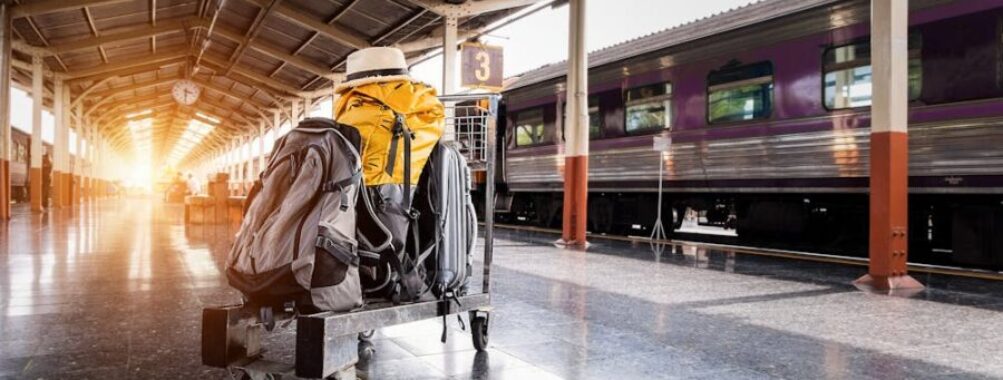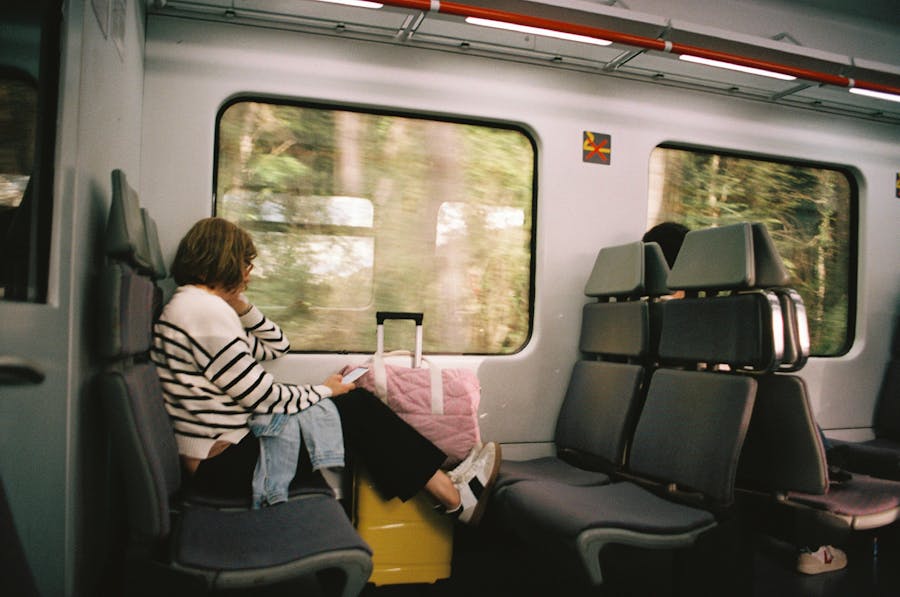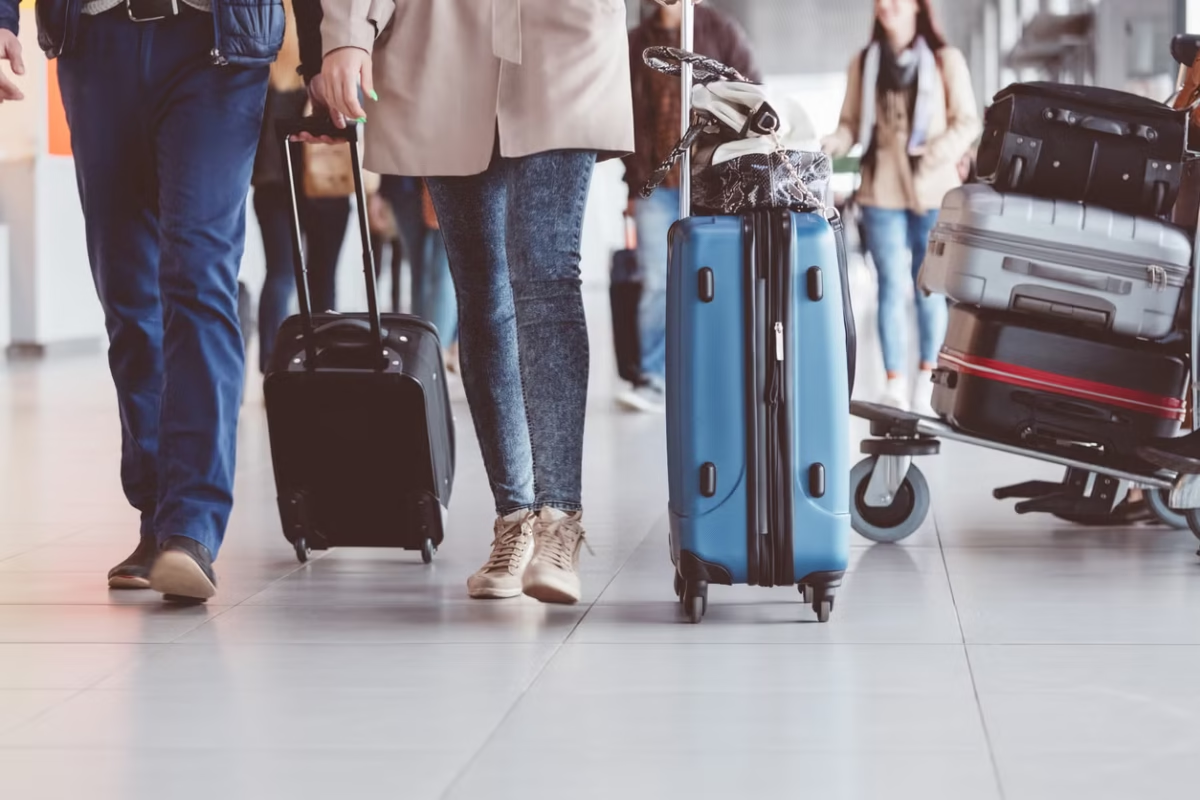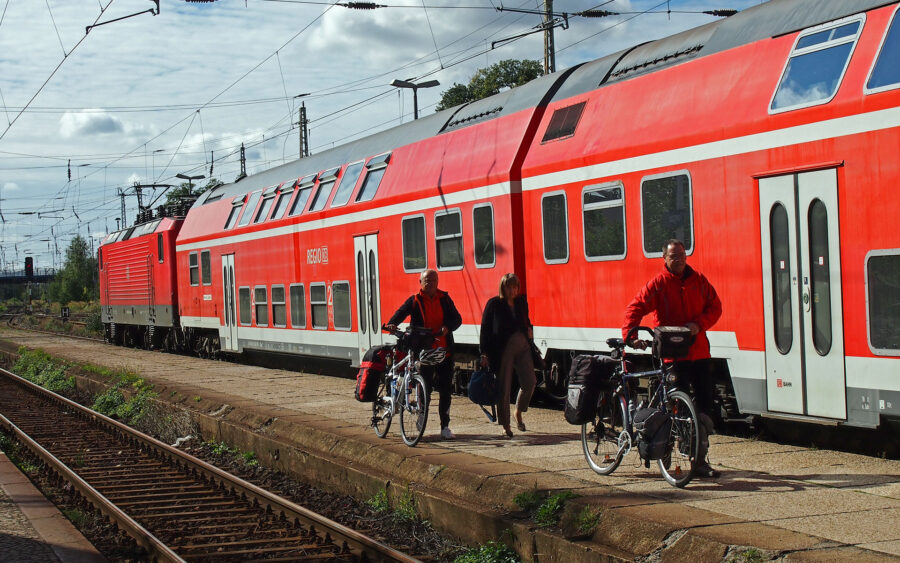
Train Luggage Size Europe by Country: Essential Rules & Surprising Limits
Packing for a European train trip? It’s trickier than you might expect. Some countries let you haul big suitcases; others, especially budget or high-speed lines, just don’t.
Most European trains skip weight checks, but your bags have to fit in racks, under seats, or on those shelves at the carriage ends. And don’t count on help—there’s no check-in counter like at the airport. You’re on your own.
I’ve definitely been the person sweating it out with a too-big bag in Spain after breezing through France. Trust me, you don’t want to be the one jamming an oversized suitcase into overhead storage while everyone’s waiting. Checking the country-specific rules before you go can save you a lot of hassle.
Table of Contents
- Key Takeaways
- Train Luggage Size Europe by Country: At-a-Glance
- Overview of Luggage Rules Across Europe
- Key Differences by Country
- Typical Size and Weight Allowances
- Country-Specific Luggage Policies
- France: SNCF, TGV, Ouigo
- Germany: Deutsche Bahn
- Italy: Trenitalia and Italo
- Spain: Renfe and Avlo
- Eurostar and Cross-Border Train Luggage Rules
- Eurostar Size and Allowance Limits
- Security and Luggage Scanning
- Registered and Oversized Baggage
- Low-Cost and Regional Trains: Special Restrictions
- Strict Limits on Budget Operators
- Luggage Fees and Penalties
- Popular Routes with Unique Rules
- Practical Packing Tips for European Train Travel
- Recommended Luggage Sizes and Types
- Efficient Packing and Storage
- Labeling and Security Advice
- Station Luggage Storage and Handling
- Left Luggage Lockers and Offices
- Navigating Stations with Bags
- Luggage Transfers and Porters
- Frequently Asked Questions
- What are the size restrictions for carry-on luggage on European trains?
- How does luggage storage differ on various train services like Eurostar, TGV, and Eurocity?
- What tips can ensure a smooth experience with luggage during European train travel?
- Are there any specific luggage limitations for international train travel within Europe?
- What should passengers know about overhead luggage racks on trains across Europe?
- Can travelers bring oversized or additional luggage on European trains, and if so, how?
- Book Your Dream Experience
- More Travel Guides
Key Takeaways
- Luggage rules change by country and train type.
- Most trains allow big bags if you can fit them in the proper spot.
- You’re responsible for hauling your own stuff from station to seat.
Train Luggage Size Europe by Country: At-a-Glance

Used to airline rules? European trains will probably feel like a relief. Usually, you can bring more than you’d think, but the specifics—especially bag sizes—shift depending on your route and which company you’re using.
Overview of Luggage Rules Across Europe
You won’t find a formal check-in for luggage on most European trains. Bring your bags on board and stash them overhead, under your seat, or in the big luggage areas at the carriage ends.
No one usually weighs your bags or measures them with a tape unless you’re on certain high-speed or budget lines.
Spain’s AVE and Avlo trains spell out their size rules, and some international routes make you tag your luggage before boarding. France’s TGVs go easy on limits, while Italy’s Trenitalia just expects you to fit your bag in the racks.
The golden rule? If you can lift it and it fits somewhere, you’re probably good.
Key Differences by Country
Spain – AVE trains let you bring three pieces, as long as the combined size is under 290 cm (height + width + depth). Avlo’s stricter: just one large bag plus a smaller personal item.
France – TGV and Intercités don’t set official size or weight limits, but your bag must fit in the racks. Eurostar (France–UK) lets you take two large bags and one small item per person.
Germany – Deutsche Bahn leaves size and weight up to you, as long as you’re not blocking aisles or doors.
Italy – Trenitalia and Italo keep things relaxed, but space can get tight on busy routes. Smaller bags are just easier to deal with.
UK – National Rail allows up to three items: two large, one small. Some operators suggest a 23 kg max per item.
These differences matter most if you’re crossing borders—you might jump from a relaxed policy to a stricter one halfway through your trip.
Typical Size and Weight Allowances
Rules vary, but here’s a general guide for most European trains:
| Item Type | Common Allowance | Notes |
|---|---|---|
| Large bag | 70–85 cm height | Must fit in rack or under seat |
| Small carry-on | 40–55 cm height | Fits overhead easily |
| Weight | ~20–25 kg | Not always enforced |
Eurostar sticks to a two large plus one small rule, but Germany’s ICE doesn’t count your bags at all.
If you’re unsure, measure your suitcase before you leave. And honestly, dragging a huge case through a crowded station in Rome or Paris is a pain, even if it’s allowed. Smaller bags just make life easier.
Country-Specific Luggage Policies

Train luggage rules in Europe aren’t universal, and sometimes the differences are bigger than you’d guess. Some operators barely glance at your bags, while others measure, weigh, and tag them before you even get on. Knowing the specifics ahead of time can save you a headache at the station.
France: SNCF, TGV, Ouigo
On most SNCF and TGV trains in France, you can bring as many bags as you can carry. They don’t set a weight limit, but your luggage must fit in the overhead racks, under your seat, or in the end-of-carriage spaces.
I’ve found a medium-sized suitcase and a backpack work best. Larger bags get awkward, especially when the train’s busy.
Ouigo, the low-cost TGV, gets stricter. Your ticket covers one small handbag (36×27×15 cm) and one cabin bag (55×35×25 cm). Anything more or bigger? You’ll pay extra—cheaper online than at the station.
Ouigo staff often check bag sizes as you board. Don’t risk it with an oversized bag unless you’ve paid for it.
Germany: Deutsche Bahn
Deutsche Bahn (DB) doesn’t fuss about luggage. No official limits on size or number, as long as you can carry them and don’t block anyone’s way.
You’ll find racks near the doors and smaller shelves above seats. On older ICE trains, overhead racks can be narrow, so a big hard-shell suitcase probably won’t fit up there.
I’ve boarded with two big bags and a backpack, and nobody cared. Still, during peak times, compact bags are your friend—space disappears fast, and you don’t want to block the aisle.
Italy: Trenitalia and Italo
Italy’s Trenitalia and Italo let you bring luggage without much fuss over size or weight. Just store your bags in the racks or overhead shelves.
High-speed Frecciarossa and Italo trains have large racks at the carriage ends for big suitcases. Overhead racks suit carry-on sized bags.
One thing I’ve noticed—Italian trains fill up quickly, and luggage space goes fast. If you board late, you might have to leave your bag in the aisle until a conductor tells you to move it. Get on early if you can.
Spain: Renfe and Avlo
Spain’s Renfe trains actually spell out their limits. On most AVE and long-distance routes, you can bring up to 3 pieces of hand luggage, with a combined weight of 25 kg and total dimensions under 290 cm. The biggest single item can be 85×55×35 cm.
On the AVE International line between Spain and France, tag your luggage before boarding. Staff will check those tags, so don’t skip it.
Avlo, Renfe’s low-cost high-speed train, is even stricter. Your ticket covers one small personal item (36×27×25 cm) and one cabin bag (55×35×25 cm). Need a bigger suitcase—up to 85×60×35 cm? Pay €10 when you book or €15 later.
I’ve watched people get caught out by Avlo’s rules and pay extra at the gate. Plan ahead to avoid surprises.
Eurostar and Cross-Border Train Luggage Rules

Taking a Eurostar or another cross-border train? You’ll want to know exactly what you can bring, how big it can be, and what happens if you show up with something oversized. Some routes add security steps that can slow you down if you’re not ready.
Eurostar Size and Allowance Limits
Eurostar keeps things pretty clear with its baggage policy, but don’t expect a free-for-all. Here’s what you can bring:
| Item Type | Limit per Passenger | Max Length (longest side) |
|---|---|---|
| Suitcases / Bags | 2 | 85 cm |
| Hand Luggage | 1 | 45 cm |
They don’t set a weight limit, but you have to lift and carry your own bags. No one wants to get stuck behind you in the aisle while you struggle.
If you’re traveling with kids, their allowance is smaller. Children under 4 travel free without a seat and don’t get their own luggage space, so pack light for them.
One thing I’ve learned: even a few centimeters over the limit can cause delays at check-in. Measure before you leave—staff do spot-check, especially at busy stations.
Security and Luggage Scanning
Eurostar stands out by running airport-style security. Every bag gets scanned before you board.
You’ll go through a metal detector, and your luggage will get X-rayed. It’s not as intense as an airport, but you still can’t bring large knives, certain tools, or flammable stuff.
This step adds time. I always show up at least 45–60 minutes early for standard class, and even earlier around holidays.
My tip—keep electronics and liquids near the top of your bag. Sometimes security asks you to take them out, and it’s just easier if you don’t have to dig.
Registered and Oversized Baggage
If your bag’s too big or you’re hauling extra stuff—like skis, instruments, or more than the allowance—you’ll need Eurostar’s registered baggage service.
You drop these items off ahead of time, but they might not travel on your train. Sometimes they arrive later, so plan for that.
There’s a fee for this, and honestly, it’s not cheap. Last time I sent a big bag, it cost more than my ticket. I stick to the free allowance whenever I can.
Bringing a bike? You have to book a bike space in advance or pack it in a bike bag that fits size rules. Show up with a regular bike and, well, you’re probably not getting on.
Low-Cost and Regional Trains: Special Restrictions

Jumping on a budget or local train in Europe? Don’t assume the same relaxed luggage rules apply. Some operators enforce strict size limits, charge extra fees, or even require luggage tags before you board. Knowing these quirks can save you cash—and stress—at the station.
Strict Limits on Budget Operators
Low-cost lines like Avlo in Spain or Ouigo in France really clamp down on baggage. It keeps fares low and boarding speedy.
Avlo, for example, includes:
- 1 personal item (max 36×27×25 cm)
- 1 cabin bag (max 55×35×25 cm)
Anything bigger? That’s extra luggage and you’ll need to pay. I once watched a couple in Madrid frantically repacking because their suitcase was just a bit too large.
Regional trains rarely measure bags, but space can be tight. If racks are full, you’ll end up with your bag at your feet, especially during rush hour.
Luggage Fees and Penalties
Budget train brands treat luggage fees like airlines do. On Avlo, a larger bag (up to 85×60×35 cm) costs €10 if you add it when booking, but €15 if you wait.
Show up with an unpaid, oversized bag? Expect a penalty fee at the station—and sometimes, they won’t let you board until you sort it. Ouigo’s unbooked extra luggage fee can be higher than your ticket.
Always check the total dimension rule (length + width + depth). Some trains count wheels and handles, which can push you over the limit before you know it.
Popular Routes with Unique Rules
Some cross-border or tourist-heavy lines have extra quirks. AVE International trains between Spain and France require luggage tagging before boarding. Staff check tags on the platform, so don’t skip it.
In Italy, Frecce trains limit you to two bags in Standard and Premium classes, with a combined size of 161 cm. Go over, and you might have to pay or repack.
On certain Swiss regional lines in ski areas, you have to book oversized sports gear like snowboards ahead of time. I’ve had to carry skis in the aisle before—honestly, it’s not fun when the train’s packed and everyone’s stepping over them.
Practical Packing Tips for European Train Travel

When you’re bouncing between cities by rail, how you pack honestly shapes your whole trip. Picking the right bag, figuring out where to stash it, and keeping it safe matter just as much as what you actually bring along.
Recommended Luggage Sizes and Types
Most European trains won’t hassle you about baggage limits, but you’ll want a bag you can actually hoist onto those overhead racks or slide onto the shelf at the end of the carriage. I usually recommend a medium-sized suitcase (around 65–75 cm) or a reliable carry-on backpack for most routes.
If you’re riding high-speed lines like Eurostar, keep in mind they’ll let you take two bags up to 85 cm plus a smaller item. Night trains? Space gets tight, so a soft duffel or backpack usually fits better than a rigid suitcase.
I’ll be honest—rolling luggage and cobblestones don’t mix. If you’ll walk a lot between stations and hotels, a backpack with padded straps will save your shoulders and your sanity. I’ve spent too much time cursing suitcase wheels in old towns. Check out travel gear before you leave—it’s worth the research.
Efficient Packing and Storage
Train storage isn’t bottomless, so pack with that in mind. I always use packing cubes to keep things squished down and organized. Shoes are a space hog—bring two pairs max, and wear the big ones while you travel.
You’ll spot racks above your seat for small items, and bigger shelves at the carriage ends for suitcases. If you want your bag close, pack light enough to lift it overhead without needing help from strangers.
I’ve tucked my daypack under the seat in front of me more times than I can count. It keeps valuables nearby and doesn’t trip anyone up in the aisle. On busy routes, storage fills up fast—boarding early gives you a better shot at a decent spot.
Labeling and Security Advice
Always slap a label on your bags with your name, phone, and email. Sometimes I just stick a card inside the main compartment. You’ll thank yourself if your bag ever goes missing.
I use small cable locks or zip ties to slow down would-be thieves. On overnight trains, I’ll loop a strap around my backpack and something fixed to the bunk. It’s not Fort Knox, but it helps me sleep better.
Keep passports, tickets, and cash in a hidden pouch or a crossbody bag you never take off. Seriously, I’ve watched people leave bags unattended to grab a coffee—don’t be that person. Even in safe places, it’s just smarter to keep your eye on your stuff.
Station Luggage Storage and Handling

European train stations can be chaos, especially if you’re wrangling heavy bags. Plenty of stations offer storage and handling services, and knowing how these work before you go can really save your back.
Left Luggage Lockers and Offices
Most big stations have self-service lockers or a staffed luggage office. Lockers come in different sizes—small daypack to big suitcase. Prices? Usually €10–€15 a day for a big locker.
Staffed offices help if your bag’s oversized or you want extra security. They’ll even stash weird shapes like skis or bikes. You’ll get a paper ticket to pick up your bag later.
If the station lockers are full, try off-site storage nearby. Services like luggage storage in shops or hotels can save the day and sometimes cost less. I’ve dropped bags at these places when I landed in a city hours before check-in and didn’t want to lug everything around.
Some European stations sprawl out across several levels and endless platforms. If your bag’s heavy, plan your route from the entrance to your platform before you even get there. Some stations have escalators and lifts, but not all—especially the old classics.
It helps to know where the luggage racks are on your train before you board. Sometimes they’re at the carriage ends, sometimes overhead. Always keep valuables in a smaller bag with you.
If you’re facing a tight connection, ditch the idea of hauling multiple big bags. I’ve missed trains just by underestimating how long it takes to cross a giant station with too much stuff.
Luggage Transfers and Porters
You can hire a porter to haul your bags in some countries. France, Italy, and Spain tend to offer this at bigger stations. Look for them near the main concourse or by the platforms—they’re usually easy to spot.
A few high-speed and luxury trains even offer luggage transfer—they pick up your bags at one station and deliver them at your destination. It’s pricey, but if you’re short on time or can’t lift heavy things, it’s a relief.
Traveling with friends? Split the porter fee. I’ve done this in Madrid after a shopping spree, and it honestly saved us a lot of hassle at the end of a long day.
Frequently Asked Questions
Train travel in Europe gives you more baggage freedom than flying, but details shift depending on the route and operator. Knowing the size rules and storage quirks can really smooth out your trip.
What are the size restrictions for carry-on luggage on European trains?
Most European trains won’t measure your bag, but it needs to fit in the overhead rack or under your seat. I’d keep your main bag under about 85 cm long.
If you can lift it yourself, you’re set. Remember, no one’s carrying your bags for you on or off the train.
How does luggage storage differ on various train services like Eurostar, TGV, and Eurocity?
Eurostar spells out limits—two large bags and a small item—while TGV trains in France are more relaxed as long as your stuff fits in the racks. Eurocity services change by country; sometimes you’ll see big storage areas, other times just overhead racks.
Some high-speed trains set up big luggage racks at carriage ends, which is a lifesaver if you’re rolling with a big suitcase.
What tips can ensure a smooth experience with luggage during European train travel?
Pack light enough to move quickly on platforms—connections can get tight. I’ve suffered through crowded trains with a heavy bag, and it’s not fun.
Label your luggage and keep valuables in a small bag you never let out of sight.
Are there any specific luggage limitations for international train travel within Europe?
Sometimes, yes. Cross-border trains like Thalys or Eurostar tend to have clearer limits than domestic routes. Security checks happen more often on these, so be ready to show your bags.
If you’re switching between countries and train companies, always double-check each operator’s rules before you set off.
What should passengers know about overhead luggage racks on trains across Europe?
Overhead racks hold small bags, backpacks, or duffels. They’re definitely not as deep as airplane overheads, so big hard-shell suitcases usually won’t fit.
If you’re on the shorter side like me, hoisting a heavy bag up there can be a real struggle—stashing it on the big rack at the carriage end is usually easier.
Can travelers bring oversized or additional luggage on European trains, and if so, how?
Most European trains let you bring oversized items—think skis, bikes, or even surfboards if you’re feeling adventurous. You’ll probably need to reserve a spot or stash your gear in a special compartment, so don’t just show up and hope for the best.
If you’re traveling with extra luggage, expect to pay a small fee or look into a luggage shipping service. I’ve actually used one when I just couldn’t face dragging a suitcase up endless station stairs—total game changer, honestly.


